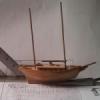MORE HANDBOOKS ARE ON THEIR WAY! We will let you know when they get here.
×
-
Posts
832 -
Joined
-
Last visited
Reputation Activity
-
 woodrat got a reaction from GrandpaPhil in The Elusive Hulc by woodrat - FINISHED - 1:32 - plank-on-frame - a speculative reconstruction of a mediaeval merchantman
woodrat got a reaction from GrandpaPhil in The Elusive Hulc by woodrat - FINISHED - 1:32 - plank-on-frame - a speculative reconstruction of a mediaeval merchantman
I have completed planking up to deck level and taken the hull off its stand. The hull is seen to be quite barge-like which I believe the hulc was , if it existed, and betrays its probable fluvial origin. Obviously there would be a tendency to leeway and lee boards are not fitted. One of the advantages of reverse-clinker, it is said, is the resistance to leeway given by the horizontally directed plank edges . It is also said that the same feature minimises the amount of heeling in a cross sea. Perhaps the sailors can tell me if this is all cods. The hull is very light but quite strong even without rivets, which I will fit soon. Floors and cross members will add tranverse strength and hopefully prevent twisting or hogging.
rivets,
Cheers
Dick
-
 woodrat got a reaction from GrandpaPhil in The Elusive Hulc by woodrat - FINISHED - 1:32 - plank-on-frame - a speculative reconstruction of a mediaeval merchantman
woodrat got a reaction from GrandpaPhil in The Elusive Hulc by woodrat - FINISHED - 1:32 - plank-on-frame - a speculative reconstruction of a mediaeval merchantman
Thanks, PietFriet. Wise words. I think a little break from the build is needed. There is still enjoyment and, having reviewed all my images, there is enough there to justify a reverse clinker model.
A frieze from the Chapter house of Salisbury Cathedral showing noahs ark dated to 1230 CE. Undoubtedly this shows reverse clinker and the sculptor has taken trouble to be accurate.
Dick🙂
-
 woodrat got a reaction from mtaylor in The Elusive Hulc by woodrat - FINISHED - 1:32 - plank-on-frame - a speculative reconstruction of a mediaeval merchantman
woodrat got a reaction from mtaylor in The Elusive Hulc by woodrat - FINISHED - 1:32 - plank-on-frame - a speculative reconstruction of a mediaeval merchantman
I find myself at a crossroads and I dont know which way the Snark has gone. If I go down the present path I am committed to a long build of a putative vessel using vague assumptions and no hard data. The other path is to shelve the hull and complete my other projects. At the end of the day is this reconstruction TOO frumious to continue. What value is this build to anyone but me and the Bellman?😕
Dick
-
 woodrat got a reaction from EricWilliamMarshall in 10th-11th century Byzantine dromon by Louie da fly - FINISHED - 1:50
woodrat got a reaction from EricWilliamMarshall in 10th-11th century Byzantine dromon by Louie da fly - FINISHED - 1:50
They are a bit reluctant to supply methylene chloride because of its toxicity so they usually sell other glues to the general public. That's my experience. BUt you can get it if you go to the bulk supplier in your town. They also have these cute squeezy bottles with a needle on it that lets you run the stuff into the join. Worth a try. A couple of boards joined at an exact right angle and positioned like a V will support the sheets while applying the liquid methylene chloride.
Dick
-
 woodrat got a reaction from EJ_L in 10th-11th century Byzantine dromon by Louie da fly - FINISHED - 1:50
woodrat got a reaction from EJ_L in 10th-11th century Byzantine dromon by Louie da fly - FINISHED - 1:50
Steven, The proper adhesive for polycarbonate is, I believe, methylene chhloride. This a bit toxic and you have to hold the sheets in jigs and run the liquid along the seam with a needle and syringe. This will actually fuse the sheets together. Superglue will produce clouding at the join. I elected to put he polycarbonate in slotted wooden frames which means they can be replaced if scratched. This is the third large case I have done this way ( see my round ship build, last page). Also see this link:
https://www.cutplasticsheeting.co.uk/blog/uncategorized/how-to-glue-polycarbonate/
-
 woodrat got a reaction from EricWilliamMarshall in The Elusive Hulc by woodrat - FINISHED - 1:32 - plank-on-frame - a speculative reconstruction of a mediaeval merchantman
woodrat got a reaction from EricWilliamMarshall in The Elusive Hulc by woodrat - FINISHED - 1:32 - plank-on-frame - a speculative reconstruction of a mediaeval merchantman
I have completed planking up to deck level and taken the hull off its stand. The hull is seen to be quite barge-like which I believe the hulc was , if it existed, and betrays its probable fluvial origin. Obviously there would be a tendency to leeway and lee boards are not fitted. One of the advantages of reverse-clinker, it is said, is the resistance to leeway given by the horizontally directed plank edges . It is also said that the same feature minimises the amount of heeling in a cross sea. Perhaps the sailors can tell me if this is all cods. The hull is very light but quite strong even without rivets, which I will fit soon. Floors and cross members will add tranverse strength and hopefully prevent twisting or hogging.
rivets,
Cheers
Dick
-
 woodrat got a reaction from druxey in The Elusive Hulc by woodrat - FINISHED - 1:32 - plank-on-frame - a speculative reconstruction of a mediaeval merchantman
woodrat got a reaction from druxey in The Elusive Hulc by woodrat - FINISHED - 1:32 - plank-on-frame - a speculative reconstruction of a mediaeval merchantman
I find myself at a crossroads and I dont know which way the Snark has gone. If I go down the present path I am committed to a long build of a putative vessel using vague assumptions and no hard data. The other path is to shelve the hull and complete my other projects. At the end of the day is this reconstruction TOO frumious to continue. What value is this build to anyone but me and the Bellman?😕
Dick
-
 woodrat got a reaction from EricWilliamMarshall in The Elusive Hulc by woodrat - FINISHED - 1:32 - plank-on-frame - a speculative reconstruction of a mediaeval merchantman
woodrat got a reaction from EricWilliamMarshall in The Elusive Hulc by woodrat - FINISHED - 1:32 - plank-on-frame - a speculative reconstruction of a mediaeval merchantman
Thanks, PietFriet. Wise words. I think a little break from the build is needed. There is still enjoyment and, having reviewed all my images, there is enough there to justify a reverse clinker model.
A frieze from the Chapter house of Salisbury Cathedral showing noahs ark dated to 1230 CE. Undoubtedly this shows reverse clinker and the sculptor has taken trouble to be accurate.
Dick🙂
-
 woodrat got a reaction from mtaylor in Venetian Round Ship c. 13th century by woodrat - FINISHED - 1:32 scale - fully framed
woodrat got a reaction from mtaylor in Venetian Round Ship c. 13th century by woodrat - FINISHED - 1:32 scale - fully framed
Thank you all at MSW for your help and support during this build.
Cheers
Dick
-
 woodrat got a reaction from mtaylor in 10th-11th century Byzantine dromon by Louie da fly - FINISHED - 1:50
woodrat got a reaction from mtaylor in 10th-11th century Byzantine dromon by Louie da fly - FINISHED - 1:50
Steven, The proper adhesive for polycarbonate is, I believe, methylene chhloride. This a bit toxic and you have to hold the sheets in jigs and run the liquid along the seam with a needle and syringe. This will actually fuse the sheets together. Superglue will produce clouding at the join. I elected to put he polycarbonate in slotted wooden frames which means they can be replaced if scratched. This is the third large case I have done this way ( see my round ship build, last page). Also see this link:
https://www.cutplasticsheeting.co.uk/blog/uncategorized/how-to-glue-polycarbonate/
-
 woodrat got a reaction from Brinkman in The Elusive Hulc by woodrat - FINISHED - 1:32 - plank-on-frame - a speculative reconstruction of a mediaeval merchantman
woodrat got a reaction from Brinkman in The Elusive Hulc by woodrat - FINISHED - 1:32 - plank-on-frame - a speculative reconstruction of a mediaeval merchantman
I have completed planking up to deck level and taken the hull off its stand. The hull is seen to be quite barge-like which I believe the hulc was , if it existed, and betrays its probable fluvial origin. Obviously there would be a tendency to leeway and lee boards are not fitted. One of the advantages of reverse-clinker, it is said, is the resistance to leeway given by the horizontally directed plank edges . It is also said that the same feature minimises the amount of heeling in a cross sea. Perhaps the sailors can tell me if this is all cods. The hull is very light but quite strong even without rivets, which I will fit soon. Floors and cross members will add tranverse strength and hopefully prevent twisting or hogging.
rivets,
Cheers
Dick
-
 woodrat got a reaction from cog in 10th-11th century Byzantine dromon by Louie da fly - FINISHED - 1:50
woodrat got a reaction from cog in 10th-11th century Byzantine dromon by Louie da fly - FINISHED - 1:50
Steven, The proper adhesive for polycarbonate is, I believe, methylene chhloride. This a bit toxic and you have to hold the sheets in jigs and run the liquid along the seam with a needle and syringe. This will actually fuse the sheets together. Superglue will produce clouding at the join. I elected to put he polycarbonate in slotted wooden frames which means they can be replaced if scratched. This is the third large case I have done this way ( see my round ship build, last page). Also see this link:
https://www.cutplasticsheeting.co.uk/blog/uncategorized/how-to-glue-polycarbonate/
-
 woodrat got a reaction from druxey in The Elusive Hulc by woodrat - FINISHED - 1:32 - plank-on-frame - a speculative reconstruction of a mediaeval merchantman
woodrat got a reaction from druxey in The Elusive Hulc by woodrat - FINISHED - 1:32 - plank-on-frame - a speculative reconstruction of a mediaeval merchantman
I have completed planking up to deck level and taken the hull off its stand. The hull is seen to be quite barge-like which I believe the hulc was , if it existed, and betrays its probable fluvial origin. Obviously there would be a tendency to leeway and lee boards are not fitted. One of the advantages of reverse-clinker, it is said, is the resistance to leeway given by the horizontally directed plank edges . It is also said that the same feature minimises the amount of heeling in a cross sea. Perhaps the sailors can tell me if this is all cods. The hull is very light but quite strong even without rivets, which I will fit soon. Floors and cross members will add tranverse strength and hopefully prevent twisting or hogging.
rivets,
Cheers
Dick
-
 woodrat got a reaction from Keith Black in 10th-11th century Byzantine dromon by Louie da fly - FINISHED - 1:50
woodrat got a reaction from Keith Black in 10th-11th century Byzantine dromon by Louie da fly - FINISHED - 1:50
Steven, The proper adhesive for polycarbonate is, I believe, methylene chhloride. This a bit toxic and you have to hold the sheets in jigs and run the liquid along the seam with a needle and syringe. This will actually fuse the sheets together. Superglue will produce clouding at the join. I elected to put he polycarbonate in slotted wooden frames which means they can be replaced if scratched. This is the third large case I have done this way ( see my round ship build, last page). Also see this link:
https://www.cutplasticsheeting.co.uk/blog/uncategorized/how-to-glue-polycarbonate/
-
 woodrat got a reaction from Louie da fly in 10th-11th century Byzantine dromon by Louie da fly - FINISHED - 1:50
woodrat got a reaction from Louie da fly in 10th-11th century Byzantine dromon by Louie da fly - FINISHED - 1:50
Steven, The proper adhesive for polycarbonate is, I believe, methylene chhloride. This a bit toxic and you have to hold the sheets in jigs and run the liquid along the seam with a needle and syringe. This will actually fuse the sheets together. Superglue will produce clouding at the join. I elected to put he polycarbonate in slotted wooden frames which means they can be replaced if scratched. This is the third large case I have done this way ( see my round ship build, last page). Also see this link:
https://www.cutplasticsheeting.co.uk/blog/uncategorized/how-to-glue-polycarbonate/
-
 woodrat got a reaction from mtaylor in The Elusive Hulc by woodrat - FINISHED - 1:32 - plank-on-frame - a speculative reconstruction of a mediaeval merchantman
woodrat got a reaction from mtaylor in The Elusive Hulc by woodrat - FINISHED - 1:32 - plank-on-frame - a speculative reconstruction of a mediaeval merchantman
I have completed planking up to deck level and taken the hull off its stand. The hull is seen to be quite barge-like which I believe the hulc was , if it existed, and betrays its probable fluvial origin. Obviously there would be a tendency to leeway and lee boards are not fitted. One of the advantages of reverse-clinker, it is said, is the resistance to leeway given by the horizontally directed plank edges . It is also said that the same feature minimises the amount of heeling in a cross sea. Perhaps the sailors can tell me if this is all cods. The hull is very light but quite strong even without rivets, which I will fit soon. Floors and cross members will add tranverse strength and hopefully prevent twisting or hogging.
rivets,
Cheers
Dick
-
 woodrat got a reaction from Vivian Galad in Venetian Round Ship c. 13th century by woodrat - FINISHED - 1:32 scale - fully framed
woodrat got a reaction from Vivian Galad in Venetian Round Ship c. 13th century by woodrat - FINISHED - 1:32 scale - fully framed
I have made a new home for the vessel whom I now name La Serenissima
Cheers
Dick
-
 woodrat got a reaction from popash42 in Venetian Round Ship c. 13th century by woodrat - FINISHED - 1:32 scale - fully framed
woodrat got a reaction from popash42 in Venetian Round Ship c. 13th century by woodrat - FINISHED - 1:32 scale - fully framed
I have made a new home for the vessel whom I now name La Serenissima
Cheers
Dick
-
 woodrat got a reaction from popash42 in Venetian Round Ship c. 13th century by woodrat - FINISHED - 1:32 scale - fully framed
woodrat got a reaction from popash42 in Venetian Round Ship c. 13th century by woodrat - FINISHED - 1:32 scale - fully framed
At the helpful suggestion of prof. Mauro Bondioli, I have changed the quarterdeck rail from neo-classical kitsch to something more in keeping with the era.
Dick
-
 woodrat got a reaction from Schrader in Venetian Round Ship c. 13th century by woodrat - FINISHED - 1:32 scale - fully framed
woodrat got a reaction from Schrader in Venetian Round Ship c. 13th century by woodrat - FINISHED - 1:32 scale - fully framed
The shroud rigging.
Pendant blocks connected to shroud by toggles. Lower blocks connected to ring bolts on deck. The tackle needs to be able to be rapidly adjusted during tacking. Lee shrouds are kept slack and the weather shrouds taut.
Cheers
Dick
-
 woodrat got a reaction from Schrader in Venetian Round Ship c. 13th century by woodrat - FINISHED - 1:32 scale - fully framed
woodrat got a reaction from Schrader in Venetian Round Ship c. 13th century by woodrat - FINISHED - 1:32 scale - fully framed
Thanks Steven and Lupus Niger.
I have been busy making blocks for the shrouds. The mediaeval blocks are somewhat different from those of later centuries . As a model I have used the pulleys from the Mataro nao combined with pulleys seen on Carpaccio's paintings. The double blocks for the shroud pendants are in-line rather than side -by-side. Also the mediaeval blocks were often quite sizeable.
Now to make some dozens of toggles....
Merry Xmas
Dick🎅
-
 woodrat got a reaction from popash42 in Venetian Round Ship c. 13th century by woodrat - FINISHED - 1:32 scale - fully framed
woodrat got a reaction from popash42 in Venetian Round Ship c. 13th century by woodrat - FINISHED - 1:32 scale - fully framed
The hull is substantially complete now. The quarter rudders are now shipped. The starboard rudder is in use but the port rudder is not in use and has been retracted using the rudder lift and has been lashed onto one of the through-beams.
Cheers
Dick
-
 woodrat got a reaction from Archi in Venetian Round Ship c. 13th century by woodrat - FINISHED - 1:32 scale - fully framed
woodrat got a reaction from Archi in Venetian Round Ship c. 13th century by woodrat - FINISHED - 1:32 scale - fully framed
Thanks for the pic, Steven, great detail in the rigging.
Here is a couple of pics of the sternshowing the Lego lad in a more useful position. Note the crutch for the mizzen yard
The wooden structure shielding the helmsman is seen in a number of illustrations of round ship.
Dick
-
 woodrat got a reaction from Cirdan in Venetian Round Ship c. 13th century by woodrat - FINISHED - 1:32 scale - fully framed
woodrat got a reaction from Cirdan in Venetian Round Ship c. 13th century by woodrat - FINISHED - 1:32 scale - fully framed
I have made a new home for the vessel whom I now name La Serenissima
Cheers
Dick
-
 woodrat got a reaction from Schrader in Venetian Round Ship c. 13th century by woodrat - FINISHED - 1:32 scale - fully framed
woodrat got a reaction from Schrader in Venetian Round Ship c. 13th century by woodrat - FINISHED - 1:32 scale - fully framed
The new master frame modified according to the instructions of the Libro di Navigar. My previous depth of hold was incorrect. Interestingly the master frame now matches that of Contarini 1.
Dick




.thumb.jpeg.fc5d633a7b34428fcf19419a73d56d55.jpeg)








a.thumb.jpg.0d220a67a0520c621b587b05b51dcd99.jpg)